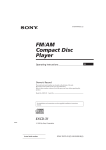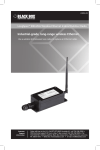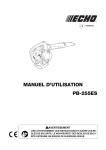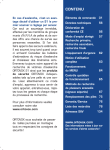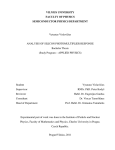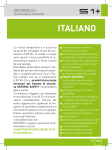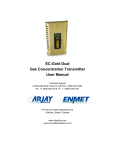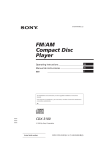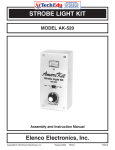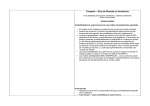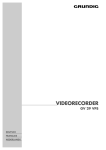Download Ortovox S1 User Manual
Transcript
Lawinen-Verschütteten-Suchgerät Avalache Transceiver Appareil de rechereche de victimes d’avalanche Loccalizzatore A.R.V.A. Aparato de búsqueda de víctimas de avalanchas Gebrauchsanleitung Manual Mode d'emploi Istruzioni per l'uso Instrucciones de uso www.ortovox.com SCAN FIND 8 7 BEDIENUNGSELEMENTE OPERATING INSTRUCTIONS 1 2 3 4 5 6 7 8 ON/OFF - Schalter Taste OK Taste MENU Batteriefach (Rückseite) Entriegelungs-Taste zum Öffnen Sende-Kontroll-Leuchten Display Sensoren (Update; Hintergrundbeleuchtung) 9 Lautsprecher 1 2 3 4 5 6 7 8 ELEMENTS DE COMMANDE ELEMENTOS DE CONTROL 1 2 3 4 5 1 2 3 4 ON/OFF switch Button OK MENU button Battery compartment (on rear) Release botton to open unit Transmission monitoring lights Display 2 sensors: update; 1 sensor: backlight 9 Loudspeaker 6 5 9 6 1 2 6 7 8 9 Touches ON/OFF Touche de OK Touche MENU Compartiment piles (au dos) Touche s de déverrouillage pour l’ouverture de l’appareil Voyants de contrôle d’émission Ecran Capteurs (mise à jour, éclairage) Haut-parleur 5 6 7 8 9 ON/OFF Tecla para OK Tecla MENÚ Compartimento de pilas (en la parte posterior) Tecla de desbloqueo Luces control - emisión Pantalla Sensores (actualización, iluminación de fondo) Altavoz 3 COMPONENTI E COMANDI OPERATIVI 4 1 2 3 4 5 6 7 8 9 Tasto ON/OFF Tasto di OK Tasto di apertura MENU Vano batteria (retro) Tasto di bloccaggio del sistema di apertura Spie di controllo della modalità di trasmissione Display Sensori (update, retroilluminazione) Altoparlante Änderungen vorbehalten 08/2009 Subject to alteration 08/2009 www.ortovox.com CONTENT Scanning the avalanche track for transmitters and locating each signal quickly and exactly are the decisive advantages of the ORTOVOX avalanche transceiver S1. An immediate search with an avalanche transceiver and a rescue using avalanche shovels and a probe that is carried out by the tour participants themselves offers the best chance of survival for an avalanche victim. When third party help has to be called to the scene it usually arrives too late! Pay attention to the avalanche report and select safe routes. Always take the avalanche transceiver S1 with you together with the necessary ORTOVOX SAFETY PRODUCTS such as an avalanche shovel and a probe. Read the S1 operating instructions carefully and practice both the handling of your avalanche transceiver S1 and avalanche search procedures. Information on ORTOVOX products and safety notices can be found on the ORTOVOX website at www.ortovox.com Contact us by e-mail at [email protected] ORTOVOX wishes you wonderful, safe tours! Operating elements 01 Technical data 36 EU Declaration of Conformity 36 QUICK REFERENCE 37 Coarse search, refining location and pinpoint location 40 Exdended operating instructions 46 MENUE 47 Daily function test 50 Locating several avalanche victims 52 Acoustic emergency reception 56 Interference 60 Battery change 61 Warranty 62 Service 63 Index of key words 64 Service addresses 164 www.ortovox.com Current avalanche warning service information! EU DECLARATION OF CONFORMITY TECHNICAL DATA Manufacturer: X-log Elektronik GmbH Responsible person: Johann Nowotny, Bahnhofstr. 95, D-82166 Gräfelfing declares that the product: Type: ORTOVOX Model: S1 Intended Purpose: Searching for avalanche victims when used as intended satisfies the basic requirements in accordance with Article 3 of the R&TTE guidelines, Directive 1999/5/EC, and that the following standards have been applied: 1. Health (Article 3.1.a of the R&TTE guidelines) ETS 300 718 issue: 05/01 2. Safety (Article 3.1.a of the R&TTE guidelines) ETS 300 718 issue: 05/01 3. Electromagnetic compatibility (Article 3.1.b of the R&TTE guidelines) ETSI EN 300 718-1 issue: 05/01 4. Efficient use of the radio frequency spectrum (Article 3.2 of the R&TTE guidelines) ETSI EN 300 718-2 issue: 05/01 5. Electromagnetic compatibility and radio spectrum matters (Article 3.3.e of the R&TTE guidelines) ETSI EN 300 718-3 issue 2004/02 DEVICE DESIGNATION: ORTOVOX S1 FUNCTION: digital with acoustic emergency operation CASING: ergonomic, waterproof, impact-resistant DIMENSIONS: 120 x 80 x 30 mm (closed); 215 x 80 x 30 mm (open) FREQUENCY Transmitting: 457 kHz The S1 can receive signals from any standard avalanche transceiver with no limitations DIGITAL RECEPTION RANGE: up to 60 m SEARCH STRIP WIDTH: up to 50 m TEMPERATURE RANGE: -20° C to +45° C IF THE TRANSCEIVER GETS WET, DO NOT USE DIRECT HEAT, I.E. SUCH AS A HAIR DRYER; TO DRY IT OUT. HEAT APPLIED IN SUCH A DIRECT MANNER MAY PERMANENTLY DAMAGE THE DEVICE BEYOND REPAIR. POWER SUPPLY: 3 alkaline AAA Mignon 1.5 V LR 03 batteries OPERATING TIME TRANSMITTING: about 250 hours RECEIVING: about 15 hours WEIGHT: approximately 245 g incl. batteries, carrying case approximately 120g SELECTABLE; ADDITIONAL FUNCTIONS • Infrared interface Gräfelfing, 09/07/2009 • Compass (City/date of the Declaration of Conformity) • Inclinometer: 0 – 60° p. p. Andrea Reintges • Thermometer: -20° to +45°C (name) The ORTOVOX S1 surpasses the high requirements of European standard EN 300 718. INFORMATION FOR THE USER: Changes or modifications to this device not approved by ORTOVOX can void the users authority to operate the equipment. FCC ID KF5ORTOVOXS1 This device complies with Part 15 of the FCC Rules. Operation is subject to the following two conditions: (1) the device may not cause harmful interference and (2) the device must accept any interference received, including interference that may cause undesired operation. This equipment has been tested and found to comply with the limits for an intentional radiator pursuant to part 15 of the FCC Rules. These limits are designed to provide reasonable protection against harmful interference in a residential installation. This equipment generates, uses, and can radiate radio frequency energy and if not installed and used in accordance with the instructions may cause harmful interference to radio communications. However, there is no guarantee that interference will not occur in a particular installation. If this equipment does cause harmful interference to radio or television reception, which can be determined by turning the equipment off and on, the user is encouraged to try to correct the interference by one or more of the following measures: • Reorient or relocate the receiving antenna. • Increase the separation between the equipment and receiver. • Connect the equipment into an outlet on a circuit different from that to which the receiver is connected. • Consult the dealer or an experienced radio/TV technician for help. WEARING THE PROTECTIVE CASE Hold the shoulder strap on the protective case by the silver-coloured application and place this over your head and shoulder. Pull the free end of the strap around your back and connect to the case using the snap buckle. SWITCH ON AND OFF SWITCH ON Turn ON/OFF switch (1) clockwise 90°. The transmission monitoring lights (6) are now flashing. When the battery capacity is between 99 and 75%, 3 short acoustic signals are emitted; between 74 and 50% battery capacity, 2 short acoustic signals are emitted; between 49 and 25% battery capacity, 1 short acoustic signal is emitted and if the battery capacity is less than 25%, a continuous alarm signal is emitted. If the equipment selt-test was not able to be completed positively, a warning signal is emitted at regular intervals. FOR THE ORTOVOX S1 AVALANCHE TRANSCEIVER ng for on enment off QUICK REFERENCE FOR THE ORTOVOX S1 AVALANCHE TRANSCEIVER QUICK REFERENCE nt. ENGLISH SWITCH OFF Turn ON/OFF switch counter clockwise 90°. 37 FOR THE ORTOVOX S1 AVALANCHE TRANSCEIVER QUICK REFERENCE TO OPEN Take the S1 from its protective case, press the release button (5) on the left side and then open the S1 unit. TRANSCEIVER SELF-TEST AND TRANSMISSION MODE When the device is opened up, once the S1 has been switched ON the transceiver self-test can be watched on the display. Symbols for transmission, reseption, additional functions and battery capacity are confirmed with ticks. The sensors on the S1 for measuring temperature, slope and the earth’s magnetism are calibrated. Close S1 after a positive transceiver self-test. This switches the S1 to transmission mode. If an error function or fault is detected, the warning triangle appears. ERROR MESSAGE During the self-test the transmit and receive functions, the sensors and the battery capacity are tested. An error message is shown on the display with the warning triangle next to the checked function; in addition 5 warning signals sound. An error message can be triggered by the imme38 ENGLISH What the most important error messages mean: E0001: transmitter E0004: magnetic sensors E0002: receiver E0008: slope sensors E0003: transmitter and receiver The S1will now transmit and the transmission indication lights on the side (6) will flash. RECEIVE = SEARCH Press the release button (5) on the left side of the beacon and open the S1. The search situation will be displayed automatically on the screen (7). FOR THE ORTOVOX S1 AVALANCHE TRANSCEIVER If one of the above or another error message is displayed, then carry out the self-test again in the open in surroundings without interference. When doing so, it is essential to make sure that no other transmitters are nearby. Switch off all sources of interference (mobile phones, wireless devices etc.) or move them well away. If the malfunction is displayed again, then send this avalanche transceiver to the ORTOVOX service department. People wearing a heart pacemaker are recommended to wear the S1 on the right side of their body. It is essential to observe the pacemaker manufacturer's instructions! QUICK REFERENCE diate proximity to another transmitting avalanche transceiver, mobile phone, wireless device, large metal parts or strong magnetic field. ORTOVOX recommends switching off mobile phones and radio equipment when locating! 39 FOR THE ORTOVOX S1 AVALANCHE TRANSCEIVER QUICK REFERENCE COARSE SEARCH: Turn the S1 left and right through an angle of approx. 30° during the COARSE SEARCH (= search for the first signal) and tilt it moderately up and down. This compensates for particularly unfavourable positions of the transmitting antenna and the signal can be picked up even earlier. If there is no transmission signal being received then the screen will automatically display instructions to carry out a coarse search. Search the avalanche track in search strips of 50 m ! REFINING LOCATION: Hold the S1 in a horizontal (flat) position during the search! At approximately 60 m distance from the victim the victim symbol will appear on the display screen (7) with the digital measurement (i.e 55). The searcher aims the vertical line to the middle of the victim symbol and then moves towards the victim. The acoustic signal from the loudspeaker will sound faster as the distance reduces and thus confirm the measurement result. If the S1 again has to determine the initial signal, the instruction to pivot the S1 appears on the display. The distance to the victim is now 20 m. Two further victims are shown at distances of 25 m and 30 m by a small icon. The nearest victim (large icon) at a distance of about 20 m remains targeted. When there are several people searching, each of the signals displayed can be targeted and simultaneously located by the other searchers. 40 DEUTSCH ENGLISH The searcher is approaching the victim: the distance is 2m, the circle becomes smaller and the arrows are pointing to the center of the circle. The searcher is moving away from the victim. The circle becomes larger, the arrows are pointing outwards as the distance increases. The previously achieved, closer position is stored and is referenced by the inner, lighter circle shown on the screen. The searcher is once again approaching the victim. The circle is becoming smaller, the arrows are pointing to the center and the distance to the victim is reducing. FOR THE ORTOVOX S1 AVALANCHE TRANSCEIVER The patented circular illustration with tendency indication on the S1 makes pinpoint location considerably easier, faster, and more precise. The process of pinpoint location begins automatically at a distance of 3m. The searcher is approaching the victim: the arrows show towards the center of the circle (tendency indication). The closer he comes to the victim the faster the acoustic signal sounds. Hold the S1 steady in front of you. Do not turn the S1 during pinpoint location! QUICK REFERENCE PINPOINT LOCATION WITH TENDENCY INDICATION: The victim has been located at a depth of 0.3 m. No smaller numbers and no smaller circles are visible. 41 FOR THE ORTOVOX S1 AVALANCHE TRANSCEIVER QUICK REFERENCE Mark To mark the located person, the “OK- button” (2) is pressed once. The marking flag appears in the display where the located person is buried. Cancelling marking The marking of the last person located can be cancelled by pressing the “OK-button” (2) again. A new pinpointing can be started immediately. If a second (third) victim is within a 3 m radius, the signal first found cannot be cancelled. In this case the pinpoint location of other victims continues in a consecutive manner as circle icons appear giving their specific respective distances, should the situation arise. If the victim is shown behind where you are standing, then change direction by 180°, home in on the victim again and walk towards the victim. 42 ENGLISH Marking a transmitter at a depth of more than approx. 6 – 7 m is not possible - in this case the victim's position is found by determining the smallest distance indication. After that, every victim shown on the display can be homed on, located and marked. Crossing the victim’s position twice in the pinpoint location area enables the position to be marked up to a burial depth of 7,0 m Extended pinpoint location area: up to 7,0 m Pinpoint location area:0,1– 3,0 m FOR THE ORTOVOX S1 AVALANCHE TRANSCEIVER You will know that the area is being crossed when the distance indicator first drops to approx. 4 to 7 m and then rises again when you continue walking. Turn around and watch again how the indicator first drops and then increases. After turning around again the pinpoint location indicator appears and you can determine the exact position as usual by using the grid search. QUICK REFERENCE Deep burial In the case of a burial depths of 3.0 to max. 7.0 m, pinpoint location is triggered by crossing the pinpoint location area twice. up to 7,0 m Burial depth: up to approx. 7,0 m 43 FOR THE ORTOVOX S1 AVALANCHE TRANSCEIVER QUICK REFERENCE 44 Simultaneous location of two victims by 2 rescuers The S1 display shows the relative position and distance of the avalanche victims. Each of the transmitters displayed can be homed on and thus directly located. 2 rescuers can locate the homed on transmitter independently of each other and thus save valuable time when rescuing the victims. DEUTSCH ENGLISH Average time needed to free a person from a snow depth of approximately 1m: Avalanche transceiver + shovel 25 minutes Only avalanche transceiver, hands, ski, snowboard 1–2 hours Illustration: Dominique Stumpert Avalanche transceiver, probe + shovel 11 minutes The illustration shows the effect of useful equipment in rescuing an avalanche victim from a depth of 1m. EVERY MEMBER OF THE GROUP SHOULD HAVE THE FOLLOWING BASIC EQUIPMENT: Avalanche transceiver Mere possession of an avalanche transceiver does not suffice. Each member of the group must be familiar with his device and practise with it regularly. (See www.ortovox.com for practice opportunities). Avalanche shovel Rescuing avalanche victims is only possible with a shovel. Avalanche probe A probe is required for fastest possible precise location with the pinpoint search procedure. First-aid kit For administration of first-aid to the injured Bivouac sack Protects against hypothermia and can be used as a transport aid. Supplemental equipment for added safety Mobile phone for organizing professional help KURZANLEITUNG für das LVS-Gerät ORTOVOX S1 You should check the EMERGENCY EQUIPMENT on the day before the tour to ensure that it is complete and functional (e.g. avalanche transceivers). Each member of the group has an avalanche transceiver on their person and a shovel and probe in the backpack. Decision-making strategies are necessary when planning a tour. For more information contact the avalanche warning services and Alpine organisations in your country. 45 EXTENDED OPERATING INSTRUCTIONS FOR THE AVALANCHE TRANSCEIVER ORTOVOX S1 TRANSMISSION AND AUTOMATIC SAFETY SWITCHBACK FOR TRANSMIT (MOTION SENSOR): If the S1 is motionless for 90 seconds while open then the transmission mode will be automatically activated from every function depending on the setting selected. In the event of a subsequent avalanche the S1 switches to transmission after 90 seconds (factory setting; time can be set at 30, 60 and 120 seconds via the “settings” menu). COURSE SEARCH (= search for first signal): Move through the presumed search area in strips with a width of 50 m while ensuring 25 m distance from the side edge of the avalanche. Several searchers: The distance between searchers is 50 m. 46 ENGLISH MENU • Accessing the menu: Press • Select function: Press several times • Confirm function: Press Search Search for more than 3 victims Compass Temperature and inclination Quick test with limited range (approx. 5 m) Acoustic search Settings 47 STATUS DISPLAY If the S1 detects 4 or more victims (=multiple burials), the "4+" icon appears on the status line of the display The searcher is requested to select the function from the menu. Warning in case of low battery Warning in case of fault Warning: Automatic transmission switch over is switched off. 48 ENGLISH SOFTKEYS The keys and have several functions. The softkeys show the respective key function: Adjust contrast Scroll forward in menu Select menu Note of marking in pinpoint location Remove marking of all located transmitters Query transmission fault during partner test Access submenu Confirm a selected function Temperature and slope measurement Recording the measured slope Carrying out a new slope measurement 49 The S1 allows the temperature and the slope angle to be measured. Measuring the slope: The tolerance of the slope sensors at 30° (degrees) can be up to +-5°. The determined measurement can be kept by pressing the "OK" button (2). A new measurement can be taken by pressing the “OK” button (2) again. DAILY FUNCTION TEST BEFORE STARTING A TOUR! Checking the receivers: • All participants set their S1 to ‘RECEIVE’. • A group member (preferably the group leader) sets his/her S1 to ‘TRANSMIT’. • If all group members have acoustic and optical reception then the group members’ receivers are working, as is the transmitter of the group leader. • The group leader now moves away from the group until no group member is still receiving a signal. • The group members see the increase in distance of the group leader on their displays and can thus test the reception range of their S1. Checking the transmitters: • The group leader opens his S1 (=reception position). The group members close their S1 (transmission position) and pass the group leader's receiver ONE BY ONE at a distance of 20 m. At the same time, the pinpoint location is tested approaching under 3 m ! 50 ENGLISH QUICK TEST with limited range (test of the transmitters) The group leader sets his/her S1 to “transmit test” via menu item (= limited range). If the S1 receives an audible (via the loudspeaker) and visible signal (circle with 2 persons) from each individual avalanche transceiver then the transmission function of the units to be tested and the reception function of the group leader are in order. If a fault turns up on the checked device then the warning triangle appears on the display. The warning triangle signals a serious device fault on the checked device. Possible faults can be queried by pressing the -button (2). Deviation from the • Transmission frequency (457 kHz) • Transmission period • Period length Go back to the short test using the -button (2). If a fault is displayed please send your transceiver directly to your ORTOVOX service office for inspection (see page 164). 51 LOCATING SEVERAL AVALANCHE VICTIMS (SIGNAL SEPARATION): The S1 separates the signals automatically. I Once the pinpoint location of the first victim is finished, this signal can be marked by pressing the “OK-button” (2). Instead of the victim symbol, a flag now appears where the victim is buried. At the same time the symbol for the next nearest victim is enlarged. This marking can be cancelled by pressing the "OK" button (2) to check the pinpoint location again if necessary. (This is not possible if several victims are transmitting within a 3 m radius.) It is necessary to have a short pause between the signals. It may take slightly longer to be able to separate three or more signals due to signal overlap. The receiver needs adequate time to differentiate between each additional transmitted signal.Thus it is practically impossible to separate more than 3-4 signals within a reasonable time and to show them on the display. The S1 therefore automatically reduces its range until the number of signals has been reduced to a quantity that can be displayed in a reasonable time. IMPORTANT NOTES REGARDING SIGNAL SEPARATION: Thank you for purchasing the Ortovox S1 employing the most innovative technology amongst today's avalanche beacons. You will find its unique visual representation and the advanced signal separation technology very helpful while searching for one or even more buried persons. Nonetheless, we want to draw your attention to some important aspects of search, especially in multiple-burial scenarios, and their physical background: In real avalanche accidents, frequently two or more persons are buried with their beacons transmitting at the same time. Sometimes, and unpredictably, two or even more beacons are transmitting their impulses exact52 ENGLISH ly simultaneously for a longer period of time. The transmitted signals of two analog beacons with long pulse durations or digital beacons transmitting simultaneously overlap and mix up. Frequently they can no longer be separated for physical reasons. In such an overlap state, a single transmitter's signal cannot be measured, neither using analog nor digital technology. Unfortunately, such an overlap state can continue for 30 or more seconds in some cases. It is necessary to wait until two overlapping impulses are drifting apart. Using the Ortovox S1, you can solve this physically determined problem applying the following three search strategies: 1. Switch to the 4+-Mode and use micro search stripes with a width of at most 5 m or 16 ft (cf. p.54) 2. Use the Ortovox sector search strategy (cf. p.55). You can combine this strategy with the 4+-mode. 3. Switch to the acoustic search mode (cf. p.56) Advice: If the number of buried persons is not known or unsure, for safety reasons it is required to use one of the aforementioned methods to detect and locate potential further buried persons. For detailed information please visit our website at www.ortovox.com Select “4+” mode to locate more than 3 transmitters Access the menu with the key and select the function When several transmission signals interfere with one another, a location procedure is not possible. Therefore the stop sign appears for a few seconds. Wait until stop hand disappears and then continue to locate! When there are more than 3 to 4 transmission signals, you will see “4+” top left. Access this function with the “menu” button (3). 53 Function "4+" The full range (approx. 50m) is available for locating the first signal. After marking the first signal the range is limited to approx. 5m. Consequently the search strips should be reduced to a width of 5 m. The restriction to a 5 m search strip width is shown by two black bars on the side of the display. Two methods for locating multiple victims: • micro-search stripes • ORTOVOX sector method MICRO-SEARCH-STRIPS Once the 1st victim has been located and rescued by helpers, the search stripes have to be set at 5 m intervals. The avalanche area is searched for victims in this way. The S1 now scans circular areas with a diameter of max. 10 m and every victim in this circle is shown. 54 ENGLISH ORTOVOX-SECTOR-METHOD 1st sector: Once the 1st victim has been located and rescued by helpers the surrounding area is searched by sectors. 2nd sector: approaching from left. 3rd sector: approaching from right. 4th sector: approaching from underneath. Before each approach in a new sector, the “4+ mode” must be restarted via the menu. Caution: It is, of course, possible to get a bearing on signals that have already been located. The searcher should then concentrate on signals that have not yet been marked in the avalanche area. 55 ACOUSTIC EMERGENCY RECEPTION (SAFETY SETTING) Receiver Transmitter Increase Volume Deacrease The ORTOVOX safety emergency reception allows an acoustic search even when the batteries have almost completely run out. When a battery change has been delayed (remaining capacity less than 10 %), sensors and display are automatically switched off, as the minimum current supply is no longer reached. Now only an acoustic reception is available. Switching "acoustic emergency reception" on and off The acoustic emergency reception can (also for training purposes) be switched on at any time by simultaneously pressing the buttons "OK" (2) and "menu" (3) for at least 5 seconds or using the menu heading "Acoustic location". Switching off the acoustic emergency reception: Close the S1 and open it again or hold down both the "OK" (2) and "menu" (3) buttons again at the same time for at least 5 seconds. If the battery capacity is very low the S1 is automatically switched to the highest possible reception level for emergency acoustic reception. The ‘OK‘ button is used to reduce the signal. The ‘menu’ button is used to increase the volume level. After initial reception the loudspeaker will sound the transmission signal. TURN the S1 in order to determine the direction with the strongest reception. Now the searcher will move in this direction for 5 m, reducing the volume if necessary. Then the searcher once again turns the S1 to the direction with the highest volume and again moves 5 m in this direction. The volume increases as the searcher moves closer to the avalanche victim. During the pinpointing phase (= lowest reception level) do not turn or tip the S1. Now mark the point in the longitudinal direction – with the loudest signal. A search is also + made for the loudest signal to the right and left of this point. The avalanche victim is located at the point with the loudest signal. 56 ENGLISH SETTINGS The following settings can be queried, selected or changed via the menu symbol • Loudspeaker • Motion Sensor settings • Information about device number, software version,receiver function and battery capacity • Display contrast setting • Update • Compass calibration Loudspeaker The loudspeaker function can be set to “loud”, “medium” and “off”. Switch to automatic transmission (Motion Sensor) If the S1 is not moved within the period of 30, 60, 90 or 120 seconds, then it automatically switches to transmission mode from whatever mode it is in. A short warning signal is emitted 10 seconds before automatically switching. The switch to automatic transmission is preset at 90 seconds when delivered.The switch to automatic transmission can also be switched off. 57 Attention: If the switch to automatic transmission is switched off, then the S1 will NOT automatically switch back to transmission mode if someone is buried by a subsequent avalanche! Information about device number, software version, receiver function and battery capacity The sub-menu shows • device number • software version • transmitter/receiver function and • current battery status Display contrast setting The desired contrast is set using the “menu” button (3) and retained with the “OK” button (2). Update The S1 can be connected to a computer via it's infrared sensors and an additional infrared scanner (accessorie) for: • update/upgrade • printout and management of transceiver's functions For more information click www.ortovox.com 58 ENGLISH COMPASS CALIBRATION To display the direction as fast as possible the ORTOVOX S1 uses an electronic compass. We recommend "calibrating" the compass before the start of every winter season and after changing the battery. Any compass discrepancy occurring is compensated by calibration. For calibration purposes, use only a flat surface without metal parts. The distance from electricity conducting leads or metal parts, particularly magnetic objects (loudspeakers) should be at least 2m. Method of procedure 1. Place the S1 on a flat, horizontal surface without metal parts (display faces upwards). 2. Select the "Settings" symbol from the "MENU". 3. Select the calibration symbol. 4. Press the "OK button", wait for approximately 2 seconds until calibration starts. 5. Turn the S1 in a horizontal position slowly (5 - 10 seconds) once around its own axis (360°). Wait for beep. 59 6. Turn over the S1. Display faces downwards. Battery compartment is visible. Wait for beep. 7. Turn over the S1 again. Display now faces upwards again. Wait for beep. The calibration process is finished. Note: After each battery change the S1 requests calibration after the self-test. Now press the "OK button" (calibration starts). Continue as from Point 5. By pressing the "MENU" button the calibration can be rejected and carried out at a later point in time. In this case the S1 reminds you to calibrate at every restart. INTERFERENCE IN TRANSMITTING AND RECEIVING PERFORMANCE Interference to the transmission and reception performance can be caused by lightening, lifts and power plants, radio equipment, mobile phones and other electronic equipment. Mobile phones and radio equipment should be switched off whilst searching. The minimum distance between two avalanche transceivers and to metal, radio equipment, mobile phones, magnets etc. should be at least 50 cm. 60 ENGLISH CHANGING BATTERIES (when the equipment is switched off) Remove the screw from the battery compartment on the back of the S1 and remove the batteries from the battery shaft using the strap. Always insert 3 new AAA 1.5V LR 03 batteries of the same make. Check the correct positon of the positive and negative poles. Use only brand name batteries. No rechargerable batteries and no lithium batteries. SEPARATING THE PROTECTIVE CASE FROM THE AVALANCHE TRANSCEIVER AND ATTACHING THE WRIST STRAP The protective case can be separated from the avalanche transceiver for cleaning purposes. The wrist strap can be attached in place of the protective case. For safety reasons, ORTOVOX only recommends using the supplied protective safety case when wearing the beacon! IMPORTANT INFORMATION! Remove the batteries from the avalanche transceiver during the summer months. The ORTOVOX factory guarantee is invalid by damage due to battery leakage. Never use rechargeable batteries (rechargeable batteries such as Ni-Cd cells). Rechargeable batteries have significantly lower operating voltage, and thus lower range and limited service life. In addition defective rechargeable batteries cannot be detected immediately. Once they have been recharged they show full battery voltage, however they can drop off to 0 after extremely short service (life threatening hazard!).If you delay changing batteries (capacity <10%), the micro-processor, the distance display, and direction display will switch off. In such case, approximately only twenty hours of emergency analog transmit operation and one hour of emergency receive operation are possible. 61 STORAGE After the tour take off the S1 and store it in its switched off status in a well-ventilated dry location. Most often, the well-designed casing prevents condensation for the most part. To ensure that the device will function for several years we recommend a gentle drying of the carrying system and the avalanche transceiver, itself. If your transceiver gets wet, do not use direct heat, i.e. hair dryer, to dry it out. Heat applied in such a direct manner may cause permanent damage. Protect the avalanche transceiver from excessive moisture or excessive heat. Protect the batteries from cold temperatures. WARRANTY When purchasing a new ORTOVOX Avalanche Transceiver, on presentation of the filled out warranty card (see instructions for use) and dealer invoice we grant the 5-year ORTOVOX guarantee from the date of purchase, but no longer than 6 years from the date of manufacture. The number IV/14 on the seal in the battery compartment means, for example: ORTOVOX guarantee valid until 4th quarter 2014; the appliance was manufactured 5 years earlier in the 4th quarter 2009. The seal also gives a reminder of the recommended transceiver test in the 4th quarter 2014. As part of the ORTOVOX guarantee, faulty parts are repaired free of charge or the avalanche transceiver is replaced by a beacon of the same design. Damage caused by improper handling and natural wear is excluded. In the case of damage due to battery leakage, the ORTOVOX guarantee is voided. Batteries are excluded from the guarantee. Any further warranty and consequential damage are expressly excluded. Enforced guarantees do not extend the guarantee obligation nor does a new guarantee period begin. Warranty expiry date IV/14 (= 4th quarter 2014) Recommended appliance test: 2014 62 ENGLISH SERVICE The ORTOVOX S1 is a rescue device. Its perfect operation might be crucial for life. To ensure your unit is functioning properly, send the device for factory inspection according to the dates shown on the test seal. Please use our inspection service in the summer months, so that your device will be ready for operation when winter starts. For repair or factory inspection please send the avalanche transceiver directly to our service center (see page 164). IMPORTANT INFORMATION! Avalanche transceivers are designed to support the assistance offered by companions in the event of avalanche burial! Your presence in areas where avalanche hazards exist is fraught with potential risk; only remain in such areas in the company of experienced participants. Effective use of an avalanche transceiver requires appropriate training and constant practice. Wear your avalanche transceiver close to your body under your outer clothing. ORTOVOX strongly recommends that you carefully read the operating instructions provided with the avalanche transceiver. Always take a shovel and a probe when you go off-piste in areas where avalanche hazards exist, and never tour alone. Give due consideration to worldwide, current Please check the avalanche reports prior to planning your off-piste activities at: www.ortovox.com Before you travel in an area where an avalanche hazard exists, ensure that all avalanche transceivers are functioning properly and that all batteries are in good operating condition. The S1 fulfils the highest safety requirements and is characterized by its clear and uniquely simple illustration of the search situation on the graphic display! 63 INDEX A Acoustic emergency reception (Safety setting) 56 Acoustic search 47, 56 Automatic transmission switch (motion sensor) 46, 57 B Battery Battery capacity Battery change Button menu Button OK 36 38, 58 61 47 47 C Coarse search 40, 46 Compass 36, 47 Conformity (EU declaration) 36 D Daily function test Deep burial Device number Display contrast setting 64 47, 50 43 58 58 E Extended operating instructions 46 Error 38 F Frequency 36 G Guarantee Card 66 I Inclinometer Infrared-sensors Interference 47, 50 58 60 L Loudspeaker 57 M Marking Marking (cancelling) Menu Multiple victims („4+-Mode“) Micro-search strips 54 54 O Open Operating elements Operating time „transmit“ Operating time „receive“ 38 01 36 36 42 42 47 ENGLISH P Protective case Printout and management of functions Pinpoint location Q Quick reference Quick test R Range Receive/search Receiver function Rechargeable battery Refining location 61 58 41 37 47, 51 36 39 58 61 40 S Search 39 Search strip width 36, 40, 46 Sector method 55 Selectable, additional functions 36,47 Self test 38 Service 63 Service Center 164 Settings 47, 57 Signal separation 52 Signal overlap 52 Softkey 49 Software Version 58 Status display STOP sign Storage Switch OFF Switch ON 48 53 62 37 37 T Technical data Thermometer 36, Transmission Indication lights Transmission (and automatic safety switchback for transmit) U Update Upgrade W Warning triangle Warranty Wrist strap 36 47 37 46 58 58 38, 48 62 61 65 GUARANTEE CARD Name City, State, Zip E-mail Telephone Model ORTOVOX S1 Serial number (inside of battery compartment lid) Purchased at Address City, State Please provide below a detailed explanation and description of your unit`s faulty performance!!!! In case of service please fill out this card and send it to the responsible ORTOVOX service center (see page 164). www.ortovox.com ✃ IMPORTANT! Please hold in safe keeping


































